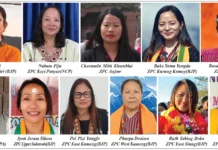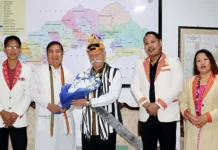[Rup J Pater]
Once upon a time – to be precise, nine years ago (to be very precise 17 July, 2016) – Arunachal Pradesh was a beautiful but distant dream for many. Scenic? Yes. Serene? Absolutely. But fast and futuristic? Maybe not so much. Fast forward to today, and we have a transformation story that could easily rival any Bollywood underdog-to-hero saga.
The economic growth story is nothing short of phenomenal. The state’s gross state domestic product (GSDP) has witnessed a staggering rise of 166% over the past decade – jumping from Rs 17,959 crore in 2014-15 to Rs 47,823 crore in 2024-25. This 2.6-times increase reflects not just a statistical surge but a deeper economic transformation powered by fiscal discipline, infrastructure investment, and inclusive development. From a slow climb in the early 2010s, the GSDP trajectory took off post-2016, marking Arunachal’s emergence as a rising economic powerhouse in the Northeast.
Yes, under the leadership of Chief Minister Pema Khandu, Arunachal has swapped its sleepy image for a dazzling digital dazzle. From hydropower to highways, e-governance to ecotourism, the state is on a turbocharged mission to redefine itself.
Picture this: 13,000+ km of new roads criss-crossing the hills like arteries pumping life into remote corners. From Vijaynagar to Tali, areas that once took days to reach can now be accessed with a sigh of relief and a smartphone GPS.
Rural roads expanded under the PMGSY alone have connected 1,187 habitations, while 2,506 kms of roads in border areas have brought accessibility to 252 remote villages.
The momentum doesn’t stop there. The 1,839-km Frontier Highway project, sanctioned with a massive investment of Rs 55,000 crore, promises to stitch together strategic locations from Bomdila to Vijaynagar. The CM’s Comprehensive State Road Development Plan (CMCSRDP) is also hard at work. With Rs 500 crore allocated for Phase II, a total of 393.57 kms of roads have been constructed so far under a total sanction of Rs 965.99 crore.
Need electricity? Arunachal is not just generating enough for itself – it’s on the way to becoming a power-surplus powerhouse, with 1,270 mw of installed hydropower capacity.
From being a power-deficit state, it is now the second power-surplus state in the Northeast. Hydropower capacity increased by 213% – from 405 mw to 1,270 mw. Over 3 lakh households have been electrified. The state now aims to tap its full potential of 58,000 mw, with 13 new hydropower projects totalling 15,000 mw beginning construction within the next three years.
You thought the state was remote? Well, now it’s digitally connected with 4G in 3,500+ villages and 5G in all districts. Yes, you read that right – 5G! Even your city cousin stuck with buffering Netflix is jealous.
To be frank, the digital revolution has been impressive. Over 3,065 villages now enjoy 4G telecom services, and all districts are 5G connected.
And yes, in a move that would make Steve Jobs smile from the clouds, the government launched CM Dashboard, e-Bhavishya, and e-Pragati, making bureaucracy finally go ‘digital-first’. The introduction of e-Office in 971 offices, with over 2.45 lakh files created and 6.5 million file movements, signifies a complete digitization of governance.
And the pièce de résistance? The Donyi Polo Airport, Itanagar, which has brought the state capital into India’s aviation map. Commercial flights now operate from Pasighat, Tezu, and Ziro, and intra-state air connectivity is supported by eight operational advanced landing grounds and 25+ helicopter service locations.
Let’s face it. Government schemes have long been the stuff of mythical creatures – often heard of, rarely seen. But in Arunachal, they are now as real as your morning chai.
Enter Seva Aapke Dwar 2.0 (with version 3.0 already in the oven). These mega service camps are not just red-tape tamasha – this is governance on foot, with babus turning into foot soldiers, marching into far-flung areas armed with certificates, awareness pamphlets, and an unwavering determination to leave no eligible citizen behind.
With over 1,051 camps and 15 lakh+ beneficiaries, this model ensures saturation of schemes, real-time data monitoring, and direct engagement with citizens.
And the numbers are inspiring. Under the Dulari Kanya Scheme, 12,174 beneficiaries have received support. The Chief Minister Aarogya Arunachal Yojana (CMAAY) has reached 1,53,284 families, covering over 6.5 lakh individuals. Another 791 youths have undergone training through the CM Yuva Kaushal Yojana.
Employment generation has seen an uptick through the Deen Dayal Upadhyay Swavalamban Yojana (DDUSY), which supported 2,648 beneficiaries. The DBT revolution has ensured that over 57,000 old-age pensioners, thousands of widows, and disabled citizens receive their benefits directly. It’s as if governance found GPS and Google Pay at the same time.
On the welfare front, the National Old Age Pension Scheme supports 10,636 people over 80 and 4,785 under 80, with state top-ups enhancing their monthly support. Similarly, 4,170 ASHAs receive a combined monthly incentive of Rs 5,000, and over 58,900 women benefit from the CM Social Security Scheme.
The list of acronyms – DDUSY, CMAAY, CMCSRDP, ANKY, MOVCD and more – might confuse even a seasoned journalist, but behind each is a story of real impact: farmers receiving subsidies, girls getting educational support, artisans being empowered, and unemployed youths being upskilled.
Through initiatives like Cabinet Aapke Dwar, ministers and bureaucrats directly interact with citizens across 26 districts. This participatory governance has led to the identification and resolution of local issues on the spot.
Education has not been left behind. Teachers under the Samagra Shiksha Abhiyan are receiving state top-ups ranging from Rs 5,000 to Rs 21,000. Under various scholarship schemes, 51,000+ students are receiving financial aid while honorariums are given to 6,225 anganwadi workers and helpers.
They say the Northeast is India’s jewel. Well, Arunachal is polishing itself into a diamond.
With 79.3% forest cover and a leading position in organic farming (kiwis, cardamoms, oranges – you name it!), Arunachal isn’t just saving the planet, it’s flavouring it too.
It ranks 1st in kiwi production, 2nd in large cardamom, and is the leading orange producer in Northeast India. Under PM-Kisan, Rs 142.67 crore has been transferred to 99,656 farmers. 96,492 kisan credit cards have been issued, covering 99.26% of eligible farmers.
Two crude palm oil mills have been established under NMEO-OP, making Arunachal the first state in India to operationalize such facilities.
Tourism, too, is booming. With a 143.76% increase in tourist arrivals from 2015 to 2024, Arunachal is no longer off the grid. Recognitions such as ‘Most Offbeat Destination’ (Outlook Travellers Award,2023) and ‘Top Mountain Destination’ (India Today) have made it a global curiosity.
Under the CM Paryatan Vikas Yojana, 1,000+ tourism entrepreneurs have received subsidies, while 156 students are currently being trained under the CM Paryatan Shiksha Yojana.
Healthcare is undergoing a renaissance. The first MBBS batch graduated from TRIHMS, where seats have doubled from 50 to 100. Institutional deliveries rose from 52.2% to 79.2%, and vaccination coverage has jumped from 38% to 77.5%.
The ‘Medicine from the Sky’ drone initiative, a first in South Asia, is now delivering vaccines and diagnostic kits to remote villages.
In sports, the state has bagged over 1,200 medals since 2016, and ranks 2nd among NE states when it comes to the medal tally of the 38th National Games 2025. The Golden Jubilee Outdoor Stadium, 20 indoor sports halls, and Khelo India Centres are nurturing talent across disciplines.
The Arunachal Olympics Mission is the cherry on the cake, preparing athletes for the 2028 and 2032 Olympics.
Meanwhile, in industry and entrepreneurship, the state has 21,982 registered MSMEs and an investment pipeline worth Rs 809 crore. Through the UNNATI Scheme and SEE Trinity, the state aims to create 25,000+ jobs in the next five years.
Chief Minister Pema Khandu has unveiled a bold vision: Arunachal Vision 2047, which focuses on ‘higher happiness’, sustainable development, and inclusive growth. The vision is aligned with the union government’s Saptarishi priorities and puts special emphasis on renewable energy, tribal welfare, and women empowerment.
The Pakke Declaration 2047, India’s first ministerial-level climate action framework, outlines 75 strategies across eight thematic pillars, covering everything from resilient healthcare to renewable energy. Already, 147 action lines have been completed, backed by Rs 1,776 crore in investments. Arunachal now boasts India’s highest carbon stock at 1,021 Mt and contributes 14.38% of the country’s carbon sequestration.
Initiatives like the Airgun Surrender Abhiyan, which saw 2,400+ guns surrendered to protect wildlife, gained international recognition, even being mentioned by the Prime Minister in Mann Ki Baat.
What was once a distant, picturesque border state is now leading from the front. Arunachal is no longer a story of potential alone; it is a live case study of what vision, grit, and grassroots governance can achieve.
So the next time someone wonders where India’s growth engine is revving loudest, just point them to the east. Arunachal isn’t waiting for the future – it’s building it, one road, one scheme, one dream at a time.
So, the next time someone says, “Oh, Arunachal? Isn’t that too far?” – just smile and reply: “Far? It’s ahead.” (The writer is PRO to Chief Minister)




